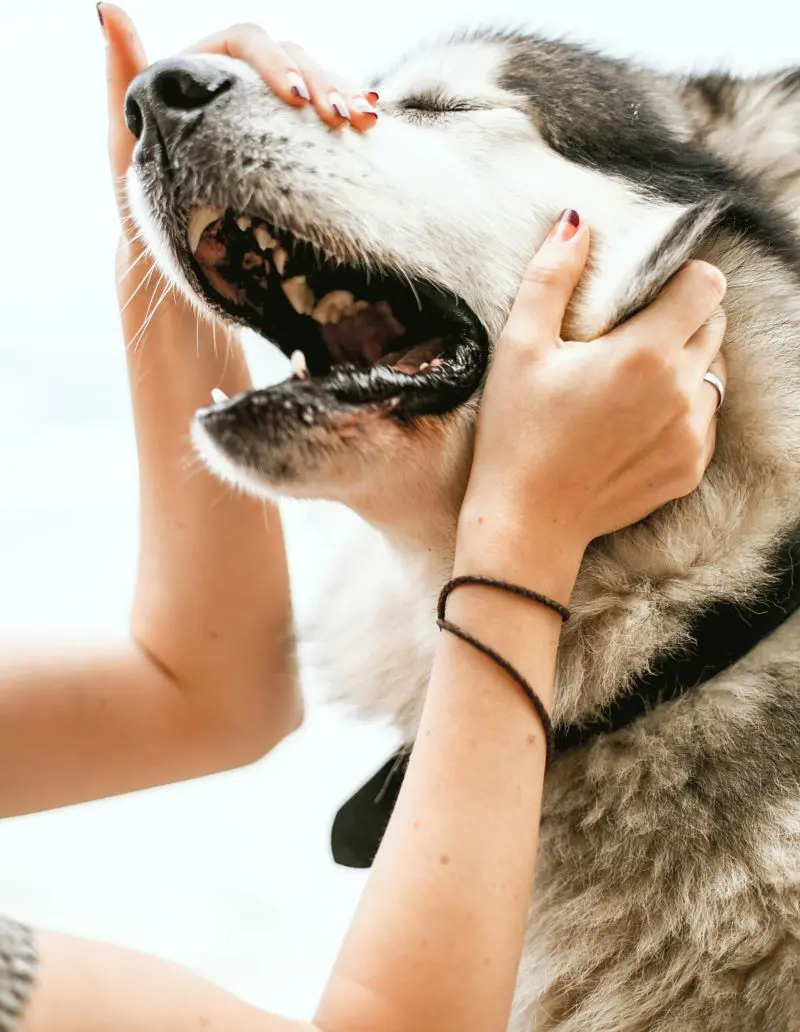How to Make a Dog Throw Up?

Throwing up in dogs can be crucial in certain emergencies, like ingesting a toxic substance. It should only be done under the guidance of a veterinarian.
Vomiting can be dangerous for dogs in certain circumstances, such as when they've ingested sharp objects or large amounts of food. It's crucial to weigh the risks and benefits before attempting to induce vomiting at home. The article will provide insights about how to make a dog vomit, including its preventive measures and considerations and when or when not to make your dog throw up.
Is It Safe To Induce Throwing Up In Dogs?

Inducing dog vomiting at home can sometimes be advisable, but due to the complex factors that come into play when deciding whether or not to do so, pet owners must consult a vet before administering any treatment.
It is never safe to induce vomiting if your dog has ingested chemicals like bleach or other cleaning products since they can cause more harm by passing through the dog's esophagus again. it can also be dangerous to induce vomiting in brachycephalic breeds, such as pugs or French Bulldogs, due to their short snouts, leading to respiratory concerns. Also, they may throw up on their own if they ingest something toxic.
When To Make Your Dog Throw Up
There are many situations where it is safe to make your dog throw up. Making a dog vomit is not always the best course of action, so it should only be done under the vet's recommendation.
Inducing vomiting is sometimes an effective way to reduce the dangerous effects of a hazardous substance. Interference before fully absorbing the toxins or foreign material moving into the intestines can make a difference in a dog's health. If you witness your dog swallowing a potentially harmful substance within the last two hours, inducing vomiting might be suitable to prevent absorption into the bloodstream.
Common Household Items Dogs Ingest
- Small Toys and Parts: Dogs, especially puppies and smaller breeds, may swallow small toys, balls, or parts of larger toys.
- Clothing and Fabric: Socks, underwear, and pieces of fabric are enticing to dogs but can cause blockages in the digestive tract.
- Household Chemicals and Medications: Dogs may accidentally ingest pills, cleaning products, or other chemicals left within their reach.
- Food Items: Bones, particularly cooked ones which can splinter, and certain fruits like grapes and raisins are toxic to dogs.
Symptoms that Indicate a Swallowed Object
- Vomiting or Attempts to Vomit: Regular attempts to vomit without producing anything could indicate an obstruction.
- Loss of Appetite: Refusing to eat or showing disregard for food.
- Abdominal Pain: Signs include restlessness, pacing, or a crouched posture.
- Changes in Bowel Movements: Diarrhea or constipation can indicate a blockage.
- Lethargy and Weakness: Your dog may appear more tired than usual and lack energy.
When Not To Make Your Dog Throw Up

While it can be tempting to eliminate a potentially harmful substance from your dog's system, there are specific situations where doing so can cause more harm than good. You should understand these circumstances to avoid worsening your dog's condition.
Some dogs will swallow things that could do a great deal of damage if vomited back up which include:
Sharp Objects
Every year, vet radiologists have a contest showing incredible radiographs of things dogs have swallowed. There is always at least one Labrodar who somehow managed to swallow the knife down.
Sharper objects, even as small as sewing needles, are best left for your vet. Inducing vomiting can exacerbate the problem by causing the object to move around in the digestive tract, potentially causing punctures, lacerations, or even perforations.
Caustic Substances
Caustic liquids, both alkaline and acidic, can damage the delicate esophageal mucosa if thrown back up. Along with liquids, remember things like batteries can leak if they are chewed on before being swallowed.
Alkaline substances like drain cleaners, oven cleaners, and battery fluids are particularly harmful. They can cause severe burns and tissue destruction. Acidic substances such as toilet bowl cleaners can also cause significant damage.
Oils
A third major object you don't want your dog not to throw up includes oils such as gasoline, kerosene, or cooking oils.
These liquids are very easy for a dog to aspirate and can cause potentially deadly pneumonia. Also, it can slow down the stomach's ability to empty its contents, which can worsen the situation if a toxic substance has been ingested.
Other Situations
Vomiting can be dangerous for dogs with certain health conditions. Dogs with these conditions are vulnerable to aspiration pneumonia as it is a high risk for the pups. Some of the other objects you don't want your dog to throw up include:
- Toxic chemicals
- Acids (such as bleach or drain cleaner)
- Alkali liquids (such as ammonia or laundry detergent)
- Paint or paint thinner
- Toxic houseplants
- Batteries, which may leak acid and cause chemical burns to the stomach and esophagus
Risks Of Inducing Vomiting Unnecessarily
Inducing vomiting in a dog without veterinary guidance can be risky and harmful. While there may be a quick solution to removing a poisonous substance, it's crucial to understand the possible consequences. Unnecessary vomiting can lead to dehydration, electrolyte imbalance, and esophageal irritation.
Additionally, if the ingested substance is sharp, vomiting can cause severe damage to the digestive tract. Some toxins become more dangerous when they come into contact with stomach acid and are regurgitated. Furthermore, there's a risk of aspiration pneumonia if the vomit enters the lungs. It's crucial to remember that not all substances are effectively removed through vomiting.
Process To Make A Dog Throw Up

Making your dog throw up is a serious decision that should only be undertaken in certain situations and with caution. Here’s a guide on how to make your dog throw up safely, emphasizing responsible pet care and veterinary guidance:
1. Assess the Situation
Before processing the steps to induce vomiting, monitor the severity of the situation. It is typically recommended in cases of recent ingestion of toxic substances or certain foreign objects.
If your dog has recently eaten something harmful but non-corrosive (like certain medications or some plants), inducing vomiting might be necessary.
2. Consult Your Veterinarian
Inducing vomiting in your dog should only be done under the guidance of a veterinarian and in specific emergencies.
Always consult your vet before inducing vomiting, even in an emergency. Based on the specific situation, they will determine if it is safe and necessary. Your vet will provide specific instructions based on your dog's health, the ingested substance, and the time gap since ingestion. They recommend, that you induce vomiting at home or bring your dog to the clinic for treatment.
3. Induce Vomiting Step by Step
After you have done your consultation with your vet before processing, you can start to process which includes:
- First, give your dog a small meal if they haven't eaten for more than 2 hours, causing them to vomit.
- Double-check that your hydrogen peroxide is 3% because higher concentrations aren't safe for your dog.
- As per the vet's recommendation, measure the dose amount that your dog needs with a syringe or a tablespoon. It mentions 1 ml per pound of body weight for 45 pounds or less and 3 tablespoons for dogs weighing 45 pounds or more.
- Give your dog the amount of hydrogen peroxide you've measured out. Be careful that your dog doesn't inhale the medication but swallows it.
- Stay with your dog while they vomit to ensure they don't try to eat anything they've brought up. Try to keep the vomit in a bowl or basin.
4. After Care And Monitoring
Ensure your dog has expelled all or most of the stomach content out of the mouth. Even if the dog vomits successfully, you should follow your veterinarian. They may recommend additional treatment or monitoring to ensure your dog's safety.
To prevent future incidents, you should take preventive measures such as dog-proofing your home and keeping harmful substances out of the dog's reach. Also, follow up with your vet as soon as possible if any signs are seen.
Alternatives to Hydrogen Peroxide
If hydrogen peroxide is unavailable for your dog, your veterinarian might suggest using salt water or ipecac syrup. Always consult your veterinarian for proper guidance.
Salt Water Solution
Mixing salt (sodium chloride) in water can also induce vomiting. The recommended dosage is 1 teaspoon of salt per cup of water. Salt water works by irritating the stomach lining, triggering the vomiting reflex.
Mustard Solutions
Mixing 1-2 teaspoons of mustard powder or mustard seeds in a cup of water can also induce vomiting. The mustard works similarly to salt water by irritating the stomach lining and stimulating the vomiting reflex.
Preventions And Considerations

There are several important precautions and considerations to ensure the safety and well-being of your canine companion. Here’s a detailed look at these precautions:
1. Consultation with a Veterinarian
Before attempting to induce vomiting in your dog, always consult a veterinarian or an animal poison control support. They can provide specific guidance based on your dog’s breed, age, health condition, and the substance ingested.
Certain dogs, such as brachycephalic breeds (e.g., Bulldogs, Pugs), may have higher risks associated with inducing vomiting due to their anatomy.
2. Identify the Substances Ingested
Identifying what your dog has ingested is essential. Different substances may require various treatments and some may be more harmful if brought back up.
For example, corrosive substances like acids or alkalis (e.g., bleach) can cause additional damage to the mouth tissues while throwing up.
3. Time Frame for Inducing Vomiting
Inducing vomiting is most effective within 30 to 120 minutes of ingestion. Beyond this gap, it may not be effective, and the substance may have already moved into the bloodstream or digestive system, requiring different treatments.
4. Do Not Use Certain Substances
Avoid using household items such as salt water, dish soap, mustard, or other chemicals to induce vomiting. These substances can be harmful and cause additional health issues, including electrolyte imbalances, dehydration, and irritation of the stomach lining.
5. Considerations for Specific Toxins
Certain toxins and substances should not be induced to vomit due to their potential to cause further harm on the way back up or because they may not be effectively expelled. These include:
Petroleum Products such as gasoline, kerosene, or motor oil. Sharp objects like needles, shards of glass, or bones could cause damage to the esophagus or intestines. Also, strong acids (e.g., toilet bowl cleaners) and alkalis (e.g., drain cleaners) can cause severe burns to the mouth, throat, and gastrointestinal tract.
6. Monitor for Signs of Distress
After inducing vomiting or attempting to do so, closely monitor your dog for any signs of distress or adverse reactions. These may include excessive drooling, difficulty breathing, weakness, collapse, or continued vomiting. If any of these signs occur, search for immediate veterinary aid.
7. Avoid Repeated Attempts
If your dog has already vomited on their own, do not attempt to induce vomiting again unless advised by a veterinarian. Multiple inductions can lead to irritation of the stomach lining and potential complications.
8. Age and Health Considerations
Consider your dog’s age and overall health status before attempting to induce vomiting. Puppies, elderly dogs, or those with pre-existing health conditions may be more vulnerable to the effects of vomiting and dehydration.
9. Preventative Measures
While it’s essential to know how to respond in emergencies, prevention is key to avoiding accidental ingestions in the first place:
Keep household chemicals, medications, toxic plants, and other potentially harmful substances securely stored and out of your dog’s reach. Especially in new environments or during activities where potential risks can be present, such as outdoor walks or visits to unfamiliar places.
What To Do If Your Dog Eat Something They Shouldn't Have

If your pet eats something they should not have, never panic. The best thing you can do is to call your veterinarian as soon as possible. Then, quickly gather information on the product your pet ate, if you know, how much they ate and when they ate. If you know these things, you can report to your vet and share everything you have found.
After getting all the information, they may want you to visit their office or local emergency hospital so they can handle the situation properly. In life-threatening conditions, animal control may be able to take advice to induce vomiting at home under specific guidance. Inducing vomiting should always be done under the guidance of a veterinary professional. Making a dog vomit is a veterinary procedure that comes with potentially life-threatening risks if done incorrectly.
Top Lists







